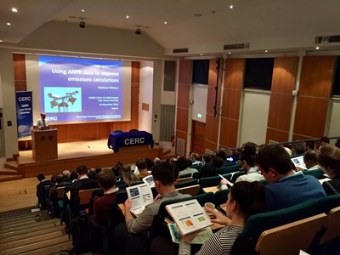CERC news
< Previous12345678910111213141516171819Next >

28 Jul 2021Registration is now open for the ADMS User Group Meetings, 24-25 November 2021, Online
The annual ADMS User Group Meetings are a great opportunity to hear the latest ADMS model news and advice from CERC consultants and model developers and to hear talks by model users about their own applications of the software. Normally held as two one-day meetings, with one day for ADMS 5 users and one day for ADMS-Urban & ADMS-Roads users, this year due to the COVID-19 pandemic we are holding a two-day meeting online for all users of ADMS software.
Tickets are available to order through Eventbrite until 23:30 on Sunday 21st November and cover the full two-day event. Organisations with a valid software support contract are entitled to one or more tickets free of charge depending on the type of licence held. Meeting connection details will be sent to registered participants before the event. The draft programme will be published soon.

11 Jun 2021CERC to present at the Harmo20 conference
CERC are pleased to be part of the upcoming 20th international Harmo conference (Harmo20), to be held online between 14 - 18 June 2021. This conference series is part of an initiative aimed at harmonising dispersion modelling for regulatory purposes.
James O'Neill will present work on the development and evaluation of a model for pollutant dispersion from elevated roads. These developments will be included in the next general release of ADMS-Roads and were funded by Highways England under the SBRI Innovate UK 'Developing digital roads and improving air quality' competition.
Our managing director, David Carruthers, will also chair a session on the topic of 'Urban scale and street canyon modelling: Meteorology, air quality and passive control systems'.

28 May 2021CERC to present at the UK's LGTAG President's conference
The Local Government Technical Advisers Group (LGTAG) President's conference will be held over three days online between 15th and 17th June 2021.
CERC is sponsoring Day 1 / Session 2 of the event and giving a presentation on Air Quality Modelling for Kensington & Chelsea, carried out by the CERC consultancy team to support Kensington & Chelsea's decision-making for Air Quality Action Plans and planning applications.
There are both morning and afternoon sessions on the 15th and 16th June, and a final session on the 17th June. Topics to be covered include air quality, climate change and active travel. More details will be coming shortly, but you can save the date or register now if you wish.


14 May 2021Modelling the temperature impact of cold plumes
CERC was commissioned to carry out a novel assessment of the impact of plumes of cold air from an array of Air Source heat Pumps (ASHPs) on the surrounding air temperature.
In work commissioned by Sustainable Energy Ltd, the CERC consultancy team used ADMS 5 and the dense gas dispersion model GASTAR to carry out dispersion modelling of the plumes of cold air. A single elevated jet, representing the emissions from a single ASHP unit, was represented in each model, and plume centreline height and temperature were output.
The ADMS 5 and GASTAR results agreed well; in both cases, temperature reductions decrease quickly with distance downstream. ADMS 5 gives more flexibility in generating and presenting results.
ADMS 5 was used to determine the meteorological conditions giving rise to the largest and smallest reduction in temperature due to the modelled jet. Stable conditions with low wind speeds gave the largest temperature reduction downstream of the release, and neutral conditions with high wind speeds gave the smallest temperature reduction; however, the difference in impact between these conditions was small.
For all meteorological conditions modelled, at receptors of various heights (trees, car park, offices and footpaths), the calculated temperature reduction was in the range 0-2 °C. Below a height of 5 m, the calculated temperature reduction was less than 1 °C.
Please click here to view the top image and here to view the bottom image in high resolution.

31 Mar 2021Breathe London Pilot network extended into the COVID-19 recovery period
The Breathe London Pilot network of static AQMesh air quality sensors has been extended into the COVID-19 recovery period. This will create a fully validated dataset covering the latest phases of the recovery. Furthermore, it will provide critical analysis, including source apportionment and emission index quantification, and data assimilation to determine emissions during the recovery phase where unprecedented changes in pollutant sources are occurring. The methodologies and techniques have wide applicability for air quality monitoring, analysis and policy beyond London and would inform similar issues elsewhere in the UK. The measurement data from the sensors is available on www.breathelondonpilot.org.
The Breathe London Pilot project was a 2-year project funded by the Clean Air Fund and delivered by a consortium led by Environmental Defense Fund (EDF) and including the current partners (University of Cambridge, CERC, ACOEM and NPL). The Breathe London Pilot network has been extended into the COVID-19 recovery period under a NERC grant.
You can also follow CERC news on Facebook, X, LinkedIn and by RSS.
< Previous12345678910111213141516171819Next >

